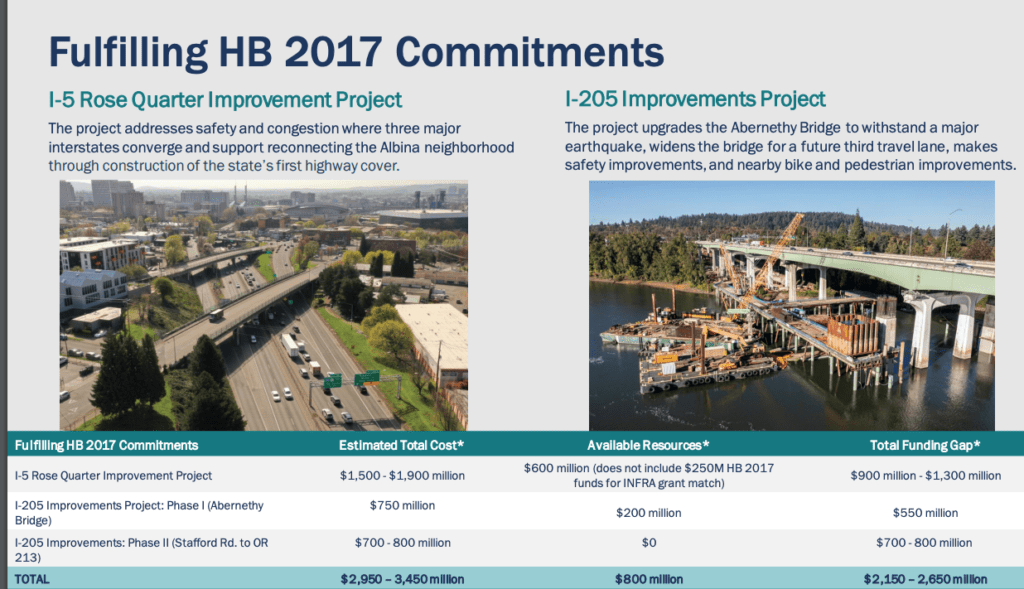How ODOT is trying to re-write history to create a commitment to freeway cost overruns.
The 2017 Legislature authorized zero funding for the I-205 Bridge project
In 2024, ODOT now falsely claims that the I-205 project was a “commitment” of the 2017 Legislature
The original HB 2017 only directed ODOT to produce a “cost to complete” study by 2018,
ODOT”s “Cost to Complete study said the Abernethy Bridge would cost $250 million—its price has now tripled to $750 million
ODOT falsely claims it can’t spend money on preservation and maintenance because of these imaginary “commitments” to freeway expansion.
As George Orwell wrote in 1984, those who control the present, control the past and those who control the past control the future.
“The past was alterable. The past never had been altered. Oceania was at war with Eastasia. Oceania had always been at war with Eastasia.”
In true Orwellian fashion, ODOT is shamelessly re-writing legislative history, manufacturing a supposed funding “commitment” to a massive highway expansion project that was specifically left out of that 2017 legislation.
The Oregon Legislature’s joint transportation committee is holding a “roadshow” a series of statewide hearings to drum up support for a 2025 transportation spending package. It’s given most of the time on the agenda over to the Oregon Department of Transportation to frame the issue. And ODOT has done so in the most misleading and inaccurate way.
ODOT, of course, presents this almost entirely as a revenue problem—ODOT simply hasn’t been given enough money—notwithstanding the massive transportation funding bill passed by the Legislature less than seven years ago. The agency says that it is merely following through on the “commitments” made in HB 2017, passed in 2017. Here’s the slide from its June 4, 2024 presentation
Seven years ago, in 2017, the Oregon Legislature passed a major transportation bill, HB 2017, which included modest funding for one interstate highway expansion project ($450 million for the I-5 Rose Quarter widening), and no funding at all for a second project, reconstructing part of I-205 (widening the existing I-205 Abernethy Bridge, in one phase, and then widening a five mile stretch of highway in a second phase).
The law adopted by the 2017 Legislature (Chapter 750 Oregon Laws, 2017) contained no funding for the I-205 project. The Legislation mentions the I-205 project, but only instructing the Oregon Department of Transportation to come up with a cost-estimate for the project.
The Legislature didn’t appropriate any money for the actual construction of the project. Instead, the Legislature’s Ways and Means Committee added a “budget note”—a kind of non-binding advice—directing the Oregon Department of Transportation to explore using congestion pricing funds to pay for I-205 in the future. In essence, the Legislature said, if and when we toll I-205 we might use toll revenues to pay for the project.
A budget note doesn’t have the force of law, and only applies in the two-year biennium for which the budget was adopted; this budget note expired on June 30, 2019. This fact is acknowledged by ODOT:
Upon passage of HB 2017, the legislature included a “budget note” directing ODOT to dedicate value pricing revenue for funding congestion relief efforts along I-205, particularly the I-205 Stafford Road to Abernethy Bridge projects. The note attached to ODOT’s 2017-2019 budget was in effect through the duration of the budgetary biennium, which ended June 30, 2019. Beyond the period of time covered by the budget note, the Oregon Transportation Commission will set policy for where revenue from value pricing should be directed, subject to further direction from the Legislature.
(Emphasis added)
ODOT excels at playing three-card monte with its budget, “finding” money for projects it wants to build, and while slashing spending on basic operations and preservation. In 2018, after the Legislature provided no funding for the I-205 Abernethy Bridge project, ODOT suddenly “found” more than $50 million in “savings”, “unanticipated revenues” and “unexpended funds” with which to launch the unfunded bridge project. And it also assumed that someday, somehow, it would have funds from the future (and as yet unimplemented Regional Mobility Pricing Program to pay for the bridge.
As we’ve already chronicled at City Observatory, ODOT’s cost to complete report claimed that widening the I-205 Abernethy Bridge would cost about $250 million. That price tag has ballooned, first to $495 million in 2021, and then to $622 million, with current estimates now conceding the project would cost $750 million.
As we warned when the Legislature was originally considering HB 2017 seven years ago, the Oregon Department of Transportation was pursuing a “driving stakes and selling bonds” strategy, copied from Robert Moses: doing anything to get a project started, including low-balling cost estimates, and then coming back to the Legislature in later years, regardless of cost increases and revenue shortfalls, and insisting on being given more money.
Now the agency is busily re-writing history. It’s saying the 2017 Legislature “committed” to the Abernethy Bridge project and widening I-205, when it only authorized ODOT to prepare a cost estimate—a cost estimate that ODOT understated by a factor of three. And congestion pricing–the source of funding ODOT used to rationalize issuing bonds, go into debt and divert funding from other projects—evaporated when Governor Tina Kotek pulled the plug on the Regional Mobility Pricing Program. So in reality, there never was any kind of financial commitment to the I-205 Abernethy Bridge project.
In short, the I-205 Abernethy Bridge project, never authorized in the HB 2017 Legislation, has effectively consumed $750 million (and with interest, even more) of the resources available to ODOT. That’s money that isn’t available for preservation and maintenance of roads. ODOT is, once again, playing a kind of financial shell game with funding, claiming that projects it chose to advance without funding represent “commitments.”


